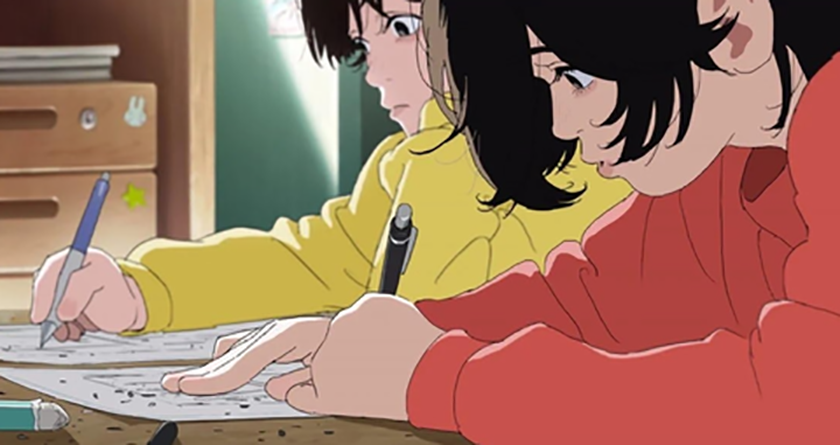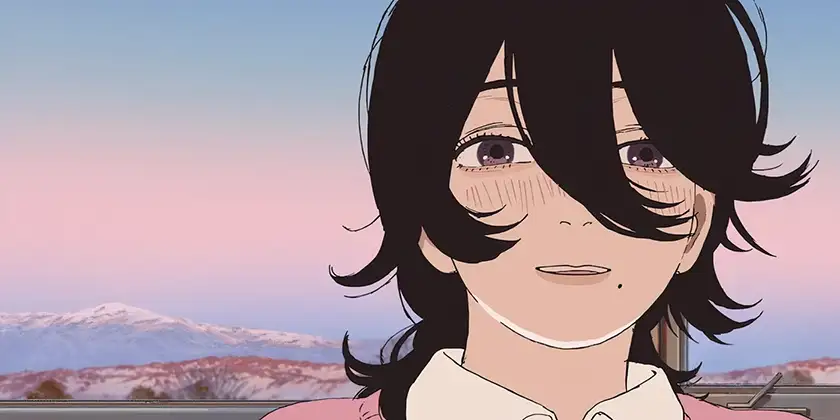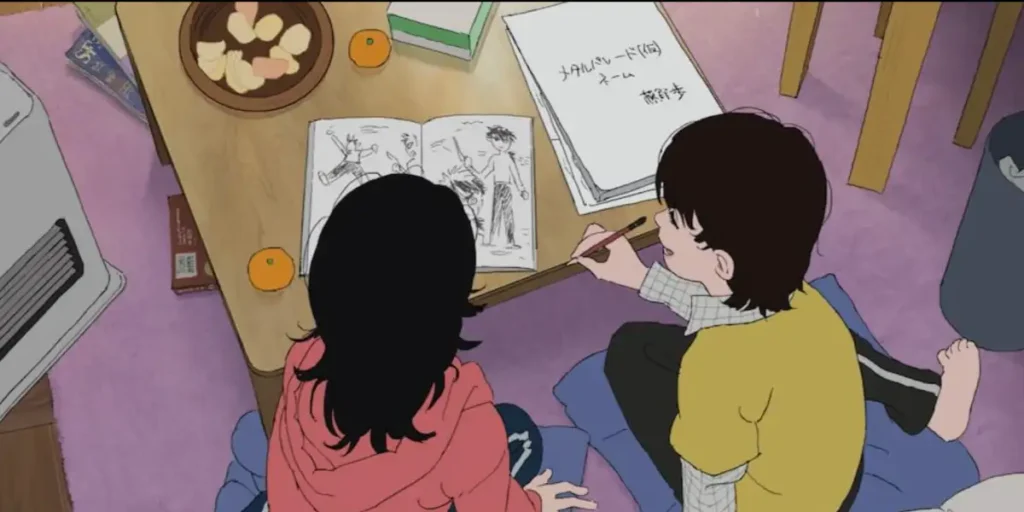Kiyotaka Oshiyama’s Look Back is guided by a spectral element that transforms Fujimoto’s manga into an introspective view of the creative process.
“Thanks for bringing me out of my room” is one of the most impactful and moving lines in Tatsuki Fujimoto’s one-shot manga, ‘Look Back’. This short manga tells a story about the emotional wavelengths of friendship, the gift of creating art, and their impact on the participants’ lives over the years, whether in moments riddled with joy or melancholy. After the success of the chaotic, madcap ‘Chainsaw Man’ series, Fujimoto sought to come to terms with “something” he had previously been unable to address, resulting in this short yet tragic and poignant manga that explores the emotional wounds he has been trying to heal for years.
This aforementioned line is the crux of the story and Fujimoto’s hindrance, reflecting on the value a significant person has in your life, inside and outside of the art world’s confines. Such a line does not affect the reader instantaneously. But after thinking about it for a few days, it got to me. It felt like a wisp of wind blowing in an enclosed room. Something, maybe that same “something” Fujimoto wanted to capture in ‘Look Back’, tapped me on the shoulder. A ghostly presence of remembrance crawls through Fujimoto’s pages and into the reader’s souls, sprouting an urgency for us to, as the title says, look back on our lives and, if you are an artist, our work as we age.
That spectral sensation appears in the film adaptation of Fujimoto’s ‘Look Back’, helmed by Kiyotaka Oshiyama (known for his work on Devilman Crybaby). With an almost hour-long runtime, Oshiyama does not want to pierce the viewer with immediate melodramatic notes. Instead, the Japanese animator and filmmaker intends to move the viewer by using simple images or lines whose definition becomes more potent as they linger in your mind and soul.
Look Back is framed through the relationship and art of two young women, Fujino (Yuumi Kawai) and Kyomoto (Mizuki Yoshida), as they reflect on their decisions to make art and their love for the creative process. The story begins when they are in middle school. Fujino is meant to be a representative of author Fujimoto, hinted at by the similarity in their names. Two love to draw comedic mangas with absurd creations–one of Fujino’s mangas calls back to Fujimoto’s beloved ‘Chainsaw Man’. Yet, they see their art as inferior to the mangakas, even though they achieve a certain level of success with their artistic style and personality.

Fujino writes short manga strips for the school newspaper. She is praised and admired by her classmates. There is an arrogance to Fujino. She mentions that her latest manga, about two lovers getting into a car crash, was made in five minutes. And it is a blatant lie, because we see her drawing until late at night, trying to get everything right. As a departure from the source material, Oshiyama brings that, and some other, manga strips to life, adding some personality and levity to the adaptation. Her cocky composure because of her talent is soon stopped upon the appearance of Kyomoto (Yoshida), a reclusive student that can’t go to school for unspecified reasons.
Fujino may not know it now, but Kyomoto will change her life for the better, and vice versa. The teacher handling the school newspaper asks Fujino to share a space with Kyomoto on the paper so she can have her art showcased. Fujino does not care, believing it will not be up to her standard. Soon enough, the entire school is in awe of Kyomoto’s work, which causes Fujino to go insane and fall into jealousy. Kyomoto does beautiful background art that looks like a wunderkind made it. Everybody deems it more sophisticated and mature than Fujino’s comic manga.
This one-sided artistic feud draws Fujino into a reclusive space to improve her drawing skills and create art like Kyomoto’s. She spends entire days and nights on her desk as time passes and the seasons change. Fujino’s drive to become better consumes her essence. It may be a simple way of showing such. But I felt personally attached to such an image because I could see myself, and many of my colleagues, on that same desk as time passed, and I kept writing my heart out about a particular film or topic. You sink into the blank pages of a notebook as emotions turn into words, and later, the finished piece becomes a part of you. It is a segway into your essence as a person and an artist.
This framing of the passage of time is a subtle note about why we create art, especially art in which we become vulnerable. Painters, writers, directors, and every other creative being beg that question upon stumbling on a crossroads or mental block, much like Fujino, who can’t come out with an answer upon Kyomoto’s artistic reveal. But there is a beauty within that same question. It paves the way for one to explore ways to be expressionistic in the art we create, whether it is film criticism or manga. Oshiyama points out that there is anger in that doubt of one’s creative identity. However, it is all meant to be stacked like a step-by-step process. First comes uncertainty and hesitancy, followed by understanding and renovation, which is how Look Back slowly blooms from a regular story to a transfixing one with many personal anecdotes by Oshiyama and Fujimoto.
After many months of trying to match Kyomoto’s art, Fujino quits the school newspaper mid-semester. We see her now spending more time with friends and doing activities that Fujino couldn’t do because she was immersed in her creative cage of self-doubt and diffidence. However, a favor from the teacher to deliver Kyomoto’s diploma will connect these two artistic souls for the first time in person, not through drawings in a school newspaper. And that meeting sparks a lovely friendship and a collaborative alliance that blends their art and personalities into something beautiful. They spend hours together workshopping ideas for projects and mangas seen through yet another time lapse in the background. Again, Oshiyama uses this time jump element to let the characters sink into their artistic selves. We see them grow as both people and artists.
This collaboration helps the two work on their ways of expression in the art they create and in their social lives. The former is more charismatic and vibrant in her work and personality. At the same time, the latter is more in the background, shy, and hides many emotions inside. The two learn to understand each other and be more sympathetic to each other’s perspectives in their feelings and drawings. But this process breaks midway through the movie, as Fujino and Kyomoto go separate ways into their black canvas. The viewer expects this turn of events and some other narrative threads, which somewhat diminishes their effect, especially with the overly emotional and manipulative use of Haruka Nakamura’s score. Nevertheless, Oshiyama plays that spectral element that Fujimoto implemented in the one-shot to express the inexpressible and give Look Back a powerful touch.
The way that Oshiyama and Fujimoto use this spectral element reminded me of the Interstellar scene where Matthew McConaughey’s Cooper is trapped in the tesseract – the void between time and space – and causes ripples in the past, ultimately setting the chain of events for the film’s narrative. In this case, a blank manga strip ties these time parallels together. Past, present, and potential futures are intertwined in a finale tethered to that “Thanks for bringing me out of my room” line that I fell in love with. Kyomoto says the line to Fujino: being grateful for their bond helped her move from her shut-in life into a more open one. It refers to Kyomoto being able to be open and out of this self-made prison.

This is the crux of Look Back: the emotional release of the characters’ relationship into a stronger, tangible bond that transcends the frame or the canvas they work on daily. Mysticism makes its way to the grounded story to depict the eagerness of someone wanting to go back and change a pivotal moment to relieve the pain of its outcome. In addition, it is a sentence that honors the people who influenced our art and those who have been guides for developing our creative process. It is an innovative way to portray this sensation, and it helps this simple story become even more fascinating, even though it initially arrives rather abruptly. Some of the issues with Look Back involve that abruptness, leaving little breathing room to let the emotions linger.
Oshiyama lets the story flow for the majority of its runtime. However, these emotionally heavy moments often lack the space needed for viewers to fully absorb the pain the characters feel, as the narrative quickly skips to the following sequence before we’ve had a chance to process what just happened entirely. This affects the story significantly, given the frequent occurrence of such moments. Despite this, Oshiyama adapts Fujimoto’s manga with care and empathy toward the original vision while adding new elements. Look Back is a hidden gem that stands out for its vulnerability and openness, especially in a year when most animated projects have felt quite the opposite.
Kiyotaka Oshiyama’s Look Back was released in select theaters in the US & Canada on October 4, 2024. The film will be available to watch globally on digital and on demand from November 7, 2024.

